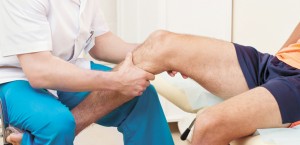By Dan Goldstein, PT, O/SCS, ATC, GFS –
 For a variety of reasons, knee pain is one of the most common complaints in Sport Medicine and Physical Therapy practices. At first glance, your knee may resemble a simple hinge, like the one that allows a door to swing open and closed. In reality, your knee is far more complex than that. The joint can make twisting and turning motions, and it allows your leg to hold up the weight of your body. Your knee also contains more moving, interacting parts than you may have realized. And because of all these factors, a lot can go wrong with different areas of the joint to cause knee pain. Let’s take a closer look at the knee and how muscle imbalance can be the cause of severe knee pain.
For a variety of reasons, knee pain is one of the most common complaints in Sport Medicine and Physical Therapy practices. At first glance, your knee may resemble a simple hinge, like the one that allows a door to swing open and closed. In reality, your knee is far more complex than that. The joint can make twisting and turning motions, and it allows your leg to hold up the weight of your body. Your knee also contains more moving, interacting parts than you may have realized. And because of all these factors, a lot can go wrong with different areas of the joint to cause knee pain. Let’s take a closer look at the knee and how muscle imbalance can be the cause of severe knee pain.
Initially, when knee pain presents, most people are concerned they have injured themselves, tearing the infamous ACL (anterior cruciate ligament) or MCL (medial collateral ligament). Frequently, however, knee pain is the result of long established imbalances between certain muscle groups.
The primary muscle group that works with the knee are those above the thigh, the quadriceps. These four muscles attach at the front of the hip and extend over the kneecap attaching to the lower leg. Typically, to compensate as these muscles weaken, natural hip movements are altered which may affect the normal smooth gliding of the kneecap causing knee pain. Unfortunately, oftentimes we don’t even realize one part of our body is compensating for another until pain presents.
The second group of muscles that can effect natural movement of the knee is the hamstrings. The hamstrings are three muscles that work together down the back of the thigh. These muscles extend from the pelvis and attach into the tibia (lower leg). Behind the knee the hamstrings interlace with part of the calf muscles (gastrocnemious muscle) which attaches into the Achilles tendon at the foot. Typically, these muscles get tight when someone experiences knee pain resulting in complaints of calf tightness, walking difficulties and problems rising from a chair.
Understanding the complexity of knee movement, it is no surprise that the emphasis of knee rehabilitation requires attention to restoring strength, flexibility, endurance, alignment and coordinating movement around this important joint.
To ensure proper healing and pain relief, initial treatment emphasizing a balanced muscle approach has to include:
1. Flexibility of the hip
2. Appropriate strengthening of the quadriceps
3. Stretching of the hamstring and calf muscles
4. Assuring smooth gliding of the kneecap
If you would like a handout of the initial stretching and strengthening exercises send me a note with your address to 1896 Palm Beach Lakes Blvd, West Palm Beach, FL 33409 or e-mail to spbalance@aol.com.
Complete rehabilitation doesn’t stop with the knee, all involved structures and movements must be examined. A close look at the alignment and muscle balance of the hip, pelvis and foot is also imparative. As already mentioned, these areas are directly affected by muscles as well as the nerves which signal our movement patterns. For example: Patients with knee pain, trying to avoid discomfort, commonly compensate by turning the foot out while walking. The result is improper movement of the ankle, more twisting instead of bending at the knee and using the wrong hip muscles. Groin pain, tightness on the outside of the thigh and hip (IT band discomfort), and foot symptoms may result. The altered walking pattern and leg position will have a negative impact on balance.
Finally, each time we take a step and the foot hits the ground; approximately 2-3 times your body weight is shocked up each leg. This force needs to be attenuated by your shoes, the arches of your foot, the calf muscles, and to some degree the quadriceps muscles on the front of the thigh. If these forces are not properly dampened the altered gait can lead to hip and low back pain. Therefore, I emphasize wearing good shoes with appropriate arch support for my clients as they rehabilitate from knee pain.
If you have knee pains, what can you do about it? Stretching the groups of muscles discussed above may help; but unfortunately, as mentioned, muscle imbalances usually throw off the mechanics of the joints in the low back, pelvis, and leg. Adjustments applied to the pelvis, leg, or low back allow joints to move freely within their normal range of motion.
Even when the pain is severe, treatment to restore balance to the muscles surrounding the knee can result in desired relief.
……………………………..
Dan Goldstein, MS, PT, OCS, SCS, ATC has been providing care for clients in West Palm Beach since 1984. If I can help answer any questions about the uses and benefits of physical therapy please call me at 561-371-6021 or e-mail me at spbalance@aol.com.
AOSPT
(561) 371 – 6021
1896 Palm Beach Lakes Blvd, Suite B
West Palm Beach, FL 33409
www.dangoldsteinpt.com
Check Also
RejuvaNATION MedSpa: Elevating Men’s Health to New Heights
Embark on a Journey to Revitalize Your Vitality Rediscover the joy of a spontaneous sex …
 South Florida Health and Wellness Magazine Health and Wellness Articles
South Florida Health and Wellness Magazine Health and Wellness Articles




